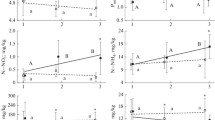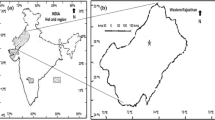Abstract
Dwarf-shrub communities of Sarcopoterium spinosum dominate large areas of the landscape on hilly, eastern Mediterranean rangelands. Colonisation of new areas depends on the establishment of seedlings that must compete for water with the ubiquitous annual herbaceous species during the spring-winter growing season and also survive the first hot, dry summer. The present study investigated the role of the herbaceous vegetation patches growing between S. spinosum shrubs on the depletion of soil water during the critical transition period between the cool, rainy season and the dry summer. Dense and sparse herbaceous vegetation stands were established in S. spinosum dwarf-shrub communities by differential use of fertiliser on two contrasting soil types – a terra rossa overlying hard limestone where seedling establishment is low and a pale rendzina overlying a soft chalk substrate where seedling establishment is high. Soil water in the main root zone of the herbaceous vegetation between the shrubs was monitored with protected gypsum block sensors permanently placed at two depths (10 and 33 cm). Soil water depletion during the transition from the wet to the dry season was significantly more rapid under dense vegetation only on the terra rossa soil where the herbaceous vegetation also matured more rapidly than on the rendzina soil. However, in both habitats and under both dense and sparse vegetation, soil water depletion during the transition period left very little available water in the rooting zone of the herbaceous vegetation to maintain shrub seedlings throughout the summer. It was concluded that the difference in shrub seedling establishment success in the two habitats mainly reflects the differences in accessibility of water below the rooting zone of the herbaceous vegetation growing on the two contrasting soil types.
Similar content being viewed by others
References
Banin A and Amiel A 1969/70 A correlative study of the chemical and physical properties of a group of natural soils of Israel. Geoderma 3, 185–198.
Bayin A 1967 [Hydrology of formations from Cenomanian-Turonian age in the central-eastern Galilee]. M.Sc. Thesis, The Hebrew University of Jerusalem, Israel (in Hebrew).
Black C A 1965 Methods for Soil Analysis. Part 1. A.S.A. Monograph No. 9, Amer. Soc. Agron., Madison, WI, USA. pp 99–104.
Dan J, Yaalon D H, Koyumdjisky H and Raz Z 1975 The soil association map of Israel (1:500,000). Pamphlet No. 147, Div. of Scientific Publications, Agricultural Research Organization, Bet Dagan, Israel.
Fowler W B and Lopushinsky W 1989 An economical digital meter for gypsum soil moisture blocks. Soil Sci. Soc. Am. J. 53, 302–305.
Goldberg D and Novoplansky A 1997 On the relative importance of competition in unproductive environments. J Ecol. 85, 409–418.
Henkin Z 1994 The Effect of Phosphorus Nutrition, Shrub Control and Fire on the Dynamics of Mediterranean Batha Vegetation in the Galilee. Ph.D. Thesis, The Hebrew University of Jerusalem, Jerusalem, Israel.
Henkin Z, Seligman N G, Noy-Meir I, Kafkafi U and Gutman M 1998a Rehabilitation of Mediterranean dwarf-shrub rangeland with herbicides, fertilizers and fire. J Range Manage. 51, 193–199.
Henkin Z, Seligman N G, Kafkafi U and Noy-Meir I 1998b 'Effective growing days': a simple predictive model of the response of herbaceous plant growth in a Mediterranean ecosystem to variation in rainfall and phosphorus availability. J Ecol. 86, 137–148.
Koyumdjiski H, Dan J, Soriano S and Nissim S 1988 Selected Profiles from Israeli Soils. ARO, The Volcani Center, Bet Dagan, Israel.
Litav M, Kupernik G and Orshan G 1963 The role of competition as a factor in determining the distribution of dwarf-shrub communities in the Mediterranean territory of Israel. J. Ecol. 51, 467–480.
Litav M and Orshan G 1971 Biological Flora of Israel. Sarcopoterium spinosum (L.) Sp. Israel J. Bot. 20, 48–64.
McAuliffe J R 1988 Markovian dynamics of simple and complex desert plant communities. Amer. Nat. 131: 459–490.
Seligman N G and van Keulen H 1989 Herbage production of a Mediterranean grassland in relation to soil depth, rainfall and nitrogen nutrition: a simulation study. Ecol. Mod. 47, 303–311.
Shultz A M, Launchbaugh J L and Biswell H H 1955 Relationship between grass density and brush seedling survival. Ecology 36, 226–238.
Spaans E J A and Baker J M 1992 Calibration of Watermark soil moisture sensors for soil matric potential and temperature. Plant Soil 143, 213–217.
Van Keulen H 1975 Simulation of water use and herbage growth in arid regions. Simulation Monographs, Pudoc, Wageningen. 176 p.
Zohary M 1973 Geobotanical Foundations of the Middle East. Gustav Fischer Verlag, Stuttgart, Germany; and Swets & Zeitlinger, Amsterdam, The Netherlands.
Author information
Authors and Affiliations
Rights and permissions
About this article
Cite this article
Henkin, Z., Seligman, N., Kafkafi, U. et al. End-of-season soil water depletion in relation to growth of herbaceous vegetation in a sub-humid Mediterranean dwarf-shrub community on two contrasting soils. Plant and Soil 202, 317–326 (1998). https://doi.org/10.1023/A:1004370019120
Issue Date:
DOI: https://doi.org/10.1023/A:1004370019120




